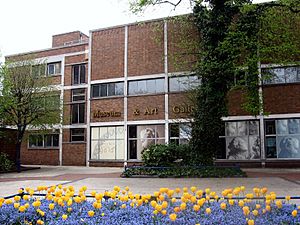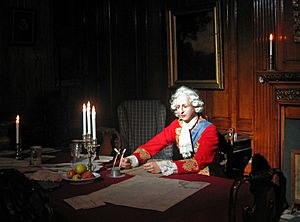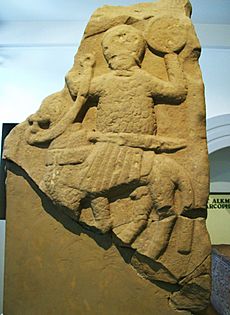Derby Museum and Art Gallery facts for kids

The 1964 extension to the original building houses the museum and art gallery in 2008
|
|
| Lua error in Module:Location_map at line 420: attempt to index field 'wikibase' (a nil value). | |
| Established | 1879 |
|---|---|
| Location | The Strand, Derby, England |
| Collections | Joseph Wright paintings |
| Owner | Derby City Council (managed by Derby Museums) |
The Derby Museum and Art Gallery is a cool place in Derby, England, where you can see amazing art and historical items. It first opened its doors in 1879. It shares a building that was designed by Richard Knill Freeman and given to Derby by Michael Thomas Bass.
Inside, you'll find a special gallery full of paintings by a famous artist named Joseph Wright of Derby. There's also a huge collection of beautiful porcelain, including Royal Crown Derby. Plus, you can explore displays about archaeology, nature, rocks, military history, and cultures from around the world. The art gallery itself officially opened in 1882.
Contents
A Look Back in Time
The museum's story began way back on February 10, 1836. That's when the Derby Town and County Museum and Natural History Society was formed. This group was private, meaning its members paid to join.
They started collecting items, with many early gifts coming from Dr. Forrester. The Duke of Devonshire was a supporter, and Sir George Crewe, who loved nature, was the president. Colonel George Gawler even donated minerals and exotic stuffed birds, like an albatross, from his time in South Australia.
In 1839, a big exhibition showed many items, including some from Joseph Strutt's collection. Many of these items later became part of the Derby Museum. The society moved to a new building in 1840.
The museum's collections kept growing. In 1856, there was an offer to give the collections to the town, but it was turned down.
In 1857, Llewellyn Jewitt became the secretary, and the museum started opening to the public on Saturday mornings. The Derby Philosophical Society joined with the museum society in 1858. This brought a library of 4,000 books and scientific tools to the collection.
In 1863, Alexander Croall, a botanist, became the first Librarian and Curator. The museum and library officially joined together the next year.
Finally, in 1870, the Derby Town and County Museum became owned by the Derby Corporation (the local government). It took a few years to find space, but the museum opened to the public on June 28, 1879. The Art Gallery followed in 1882, and in 1883, the museum even got electricity for new lighting!
In 1936, a man named Alfred E. Goodey, who had collected art for 50 years, gave a huge collection of paintings to the museum. When he passed away in 1945, he left money to build an extension. This new part, which now holds the museum, was finished in 1964. The museum has also been updated more recently, in 2010–2011.
Unfortunately, in 2012, some items were stolen from the museum's storage. These included old coins, medals, and watches. Some of the stolen items were later found.
Derby and the Age of Enlightenment
Derby was an important place during the 1700s, a time called the Age of Enlightenment. This was when people started to think more about science and new ideas. It was a period when science and philosophy began to question old ways of thinking.
Many important thinkers and scientists came together in the English Midlands. The Lunar Society was a group that included famous people like Erasmus Darwin (Charles Darwin's grandfather), Matthew Boulton, Joseph Priestley, and Josiah Wedgwood. Even Benjamin Franklin from America wrote to them!
Erasmus Darwin started the Derby Philosophical Society when he moved to Derby in 1783.
Joseph Wright's Amazing Paintings
The Derby Museum has over 300 sketches and 34 oil paintings by Joseph Wright of Derby. His paintings are famous for how he uses light and shadow. Many of his works show members of the Lunar Society.
One of his paintings is called The Alchymist in Search of the Philosopher's Stone (1771). It shows a German alchemist named Hennig Brand discovering the element phosphorus in 1669. In the painting, a flask of boiled-down liquid suddenly glows as the phosphorus catches fire in the air.
Another famous painting is A Philosopher Lecturing on the Orrery. This painting shows an early machine called an orrery that demonstrates how planets move around the Sun. A Scottish scientist named James Ferguson gave lectures in Derby in 1762. He used machines like the orrery to explain his ideas. Wright might have attended these lectures. He could also have learned about the orrery from his neighbor, John Whitehurst, who was a clockmaker and scientist.
Why Joseph Wright's Paintings Are Special
These paintings by Joseph Wright are not just pretty pictures. They also have deeper meanings. For example, the glowing phosphorus in The Alchymist can represent the shift from old beliefs to new scientific understanding. The different faces in his painting of a bird in an air pump show worries about how science might affect humanity.
These artworks show a key moment in history when scientific discovery began to change society. Because of these connections to science and the way Joseph Wright showed these ideas in his art, the Derby Museum and Art Gallery is more than just a place with nice paintings. It's important because it's in a city that played a big part in the start of modern science and industry around the world.
Wright of Derby and the City
In 2011, Derby City Council decided to use Joseph Wright of Derby to help promote the city. At the same time, the Museum announced it was working with Wikipedia to make its information even better. In February 2011, the Museums, Libraries and Archives Council (MLA) recognized Derby Museum and Art Gallery for its very important collection of Joseph Wright's paintings and drawings.
The Bonnie Prince Charlie Room

The museum has a special room that looks just like the one in Derby where Charles Edward Stuart, also known as Bonnie Prince Charlie, held a meeting in 1745. He was on his way to try and take the British crown. The wooden panels in the room are from the original Exeter House, which was taken down in 1854. These panels were brought to the museum, and other related items were donated. Even Queen Victoria gave an original letter from Bonnie Prince Charlie from her own collection!
Other Artists to See
Besides the amazing Joseph Wright collection, the museum also has works by many other artists. These include Benjamin West, E. E. Clark, Robert Priseman, Harold Gresley, Alfred John Keene, Georg Holtzendorff, David Payne, George and William Lakin Turner, Ernest Townsend, and Samuel and Louise Rayner.
Soldier's Story Gallery
The Soldier's Story gallery tells the history of several military groups. These include the 9th/12th Royal Lancers, the Sherwood Foresters, and the Derbyshire Yeomanry.
More Collections to Explore

The museum has a piece of a cross from Repton. On it, there's a carving of a man on horseback. Some people think this might be a memorial to King Æthelbald of Mercia. The figure wears armor and holds a sword and shield, with a crown on his head. King Æthelbald was killed in 757 and buried in Repton. If this carving is indeed him, it would be the oldest large picture of an English king!
The museum also has a big collection of items from the Bretby Art Pottery.
See also
 In Spanish: Derby Museum and Art Gallery para niños
In Spanish: Derby Museum and Art Gallery para niños
- Collection of Derby Museum and Art Gallery
- Derby Silk Mill (Museum of Making)
- Derwent Valley Mills
- List of museums in Derbyshire
- Quad (arts centre)




